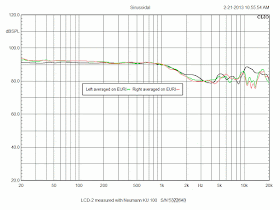Disclaimer: This review is made possible with the support from Audeze, the manufacturer of LCD-2 Rev.2. I sincerely appreciate them for loaning me a demo sample.
Continued from Part 2, General analysis.
Audeze LCD-2 Rev.2 has been scientifically proven to be superior compared to other conventionally designed headphones, thanks to its transducer's dipole mechanism. According to Dr. Carl Poldy of AKG, the transducer's superiority lies in its low distortion, deriving from the highly elastic excursion property of the membrane, and a flat response due to the low membrane mass, allowing a high system resonance. It is a no surprise that LCD-2 Rev.2 has became the top contender even in an extensive subjective assessment test.
Dr. Mendel Kleiner, who is a professor of the Division of Applied Acoustic at Chalmers University of Technology in Sweden, describes an orthodynamic driver's greatest advantage: "the entire surface area of the diaphragm is driven with about the same force per unit area." In other words, a sound wave is propagated in more even manner, in contrast to that of a moving-coil dome driver, which may introduce a motion break-up, causing asymmetrical distribution of a sound wave.
In order to figure out the driver's sound radiation characteristic, a free-field analysis has been carried out at various locations within the frontal volume of the housing using a precisely calibrated microphone. Should the free-field measurement at different locations match one another, then it can be assumed that the entire surface of LCD-2 Rev.2's driver is indeed uniformly excited, yielding the same spectral property regardless of the location of the pinna.
And the test result reveals the entire surface of the diaphragm is indeed acting all together at once in-phase relative to the input signal. There are some variations in the upper frequency range, which can be deduced that they are caused by reflections from the angled ear pad. Consequently, the large sound field gives a subjective impression, which is equivalent to that of the sound emitted from a loudspeaker in a free-air, to listeners.
Infrasound analysis
LCD-2 Rev.2 is well-known for its great deep bass quality, without ever being bloated in the low frequency range. Of course, the orthodynamic driver has higher fidelity in the bass, due to less distortion and better damping characteristic, compared to conventional technologies, but most importantly, it is claimed to be capable of reproducing the sound that is located below the audibility range of a human ear.
It is reported by a British researcher named Sarah Angliss, that an infrasound component may cause a sense of coldness, anxiety and shivers down the spine, along with any feelings greatly intensified when this is mixed with music. If it turns out that LCD-2 Rev.2's low frequency bandwidth goes all the way down to such frequency range, it is perhaps capable of stimulating the reported psychoacoustically-induced sensation.
Although the pair of pressure-field microphones equipped on EURI is not quite suitable for infrasound analysis as their specified frequency range covers from 20 Hz to 20,000 Hz, a relative comparison can still be made.
It is reported by a British researcher named Sarah Angliss, that an infrasound component may cause a sense of coldness, anxiety and shivers down the spine, along with any feelings greatly intensified when this is mixed with music. If it turns out that LCD-2 Rev.2's low frequency bandwidth goes all the way down to such frequency range, it is perhaps capable of stimulating the reported psychoacoustically-induced sensation.
Although the pair of pressure-field microphones equipped on EURI is not quite suitable for infrasound analysis as their specified frequency range covers from 20 Hz to 20,000 Hz, a relative comparison can still be made.
And the result clearly shows LCD-2's electroacoustic performance in the sub-bass is superb and unparalleled, simply blowing Sennheiser HD650 (moving-coil), and Stax Lambda Professional (electrostatic), to dust.
And these stress tests run at 1 Hz & 5 Hz reveal the physical behavior of the driver while reproducing very low infrasound components. The movement of the diaphragm resembles that of a human heartbeat; this must be where the heart of LCD-2 Rev.2 resides.
Peer review
 |
| Data measured with EURI superimposed on top of Audeze's calibration chart |
In conclusion
After its death in the early 90's, who knew orthodynamic technology could be truly reincarnated. Is this perhaps the age of second-coming? I think so. Not only the technology proves its superiority over the conventional dynamic headphones in a listening test, but has also allured competitors, such as Dr. Fang Bian's HiFiMAN series headphones, back in the scene. The high-end headphone industry is getting larger every year, as more customers are becoming aware of the fidelity of their headphones. With their cutting-edge orthodynamic transducer technology, I believe Audeze shall continuously dominate the game.
References
B. Arends and D. Thackara, Experiment: Conversations in Art and Science. Wellcome Trust, 2003.
C. A. Poldy, Chapt. 12 in Loudspeaker and headphone handbook, Borwick, J., ed., Oxford: Reed, 1994.
M. Kleiner, Acoustics and Audio Technology. J. Ross Publishing, 2012.




Rin,
ReplyDeleteThat was a Great Review.
I really enjoyed the way you broke it down into three segments.
Keep up the good work.
Jim
Thnx, Jim, as always. A lot of effort put into this analysis, so hopefully everyone enjoys it.
DeleteAwesome review.
ReplyDeletepersonally, I like a warm sounding headphone with a tight and nice low bass, cuz the Audeze lcd2 is interesting for me.
good job uber man. :)
Thanks! LCD-2's sub-bass is truly nice and tight.
DeleteGreat Review. I think this is the most scientifically approached headphone review I've ever read. As a man of science myself I approve of this! And what better headphone to review than the Audeze LCD-2s.
ReplyDeleteThnx! I am trying my best, but ain't quite there yet..
Delete